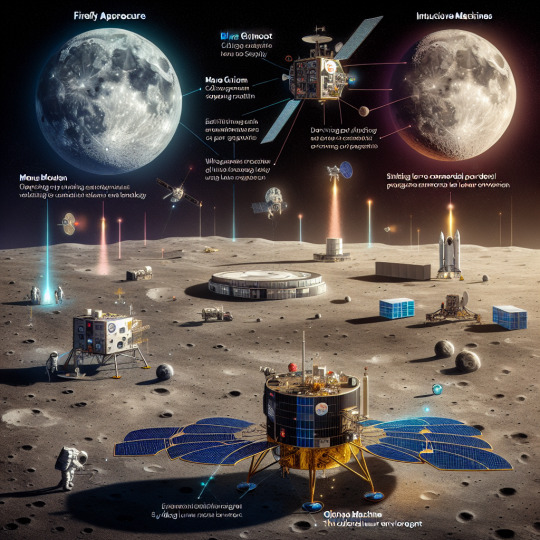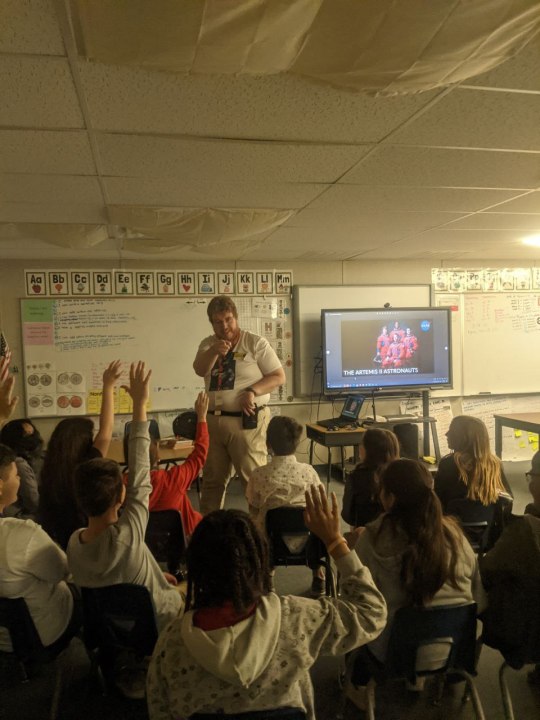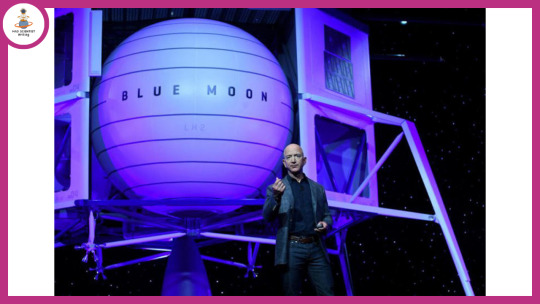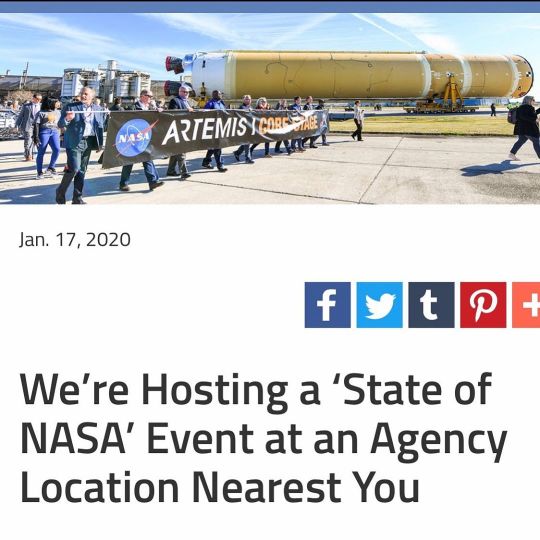#ArtemisProgram
Explore tagged Tumblr posts
Video
youtube
Blue Ghost Moon Landing - 4 Incredible Angles of Firefly's Lunar Touchdown
I was very excited during the BlueGhost Mission, It was amazing! Here is some background on Blue Ghost ands the mission:
Blue Ghost Mission 1: Firefly’s Historic Lunar Landing
Firefly Aerospace’s Blue Ghost Mission 1, dubbed "Ghost Riders in the Sky," marked the first fully successful commercial soft landing on the Moon. Launched on January 15, 2025, and landing on March 2, 2025, it delivered 10 NASA payloads to Mare Crisium under the CLPS program. Here’s the scoop!
Mission Highlights
Launch: Jan 15, 2025, via SpaceX Falcon 9 from Kennedy Space Center.
Landing: Mar 2, 2025, at Mons Latreille, Mare Crisium.
Duration: ~60 days, with 14+ days of surface ops, surviving 5 hours into lunar night.
Data: Transmitted 119 GB, including 51 GB of science data.
The Lander
Named after the Phausis reticulata firefly, Blue Ghost is a 2m-tall, 3.5m-wide lander with:
Carbon composite structure for lightweight durability.
Three solar panels (400W) and robust X/S-band antennas for HD video.
1,000N main engine + eight 200N thrusters for precise landing.
Payloads
Carried 10 NASA payloads (94 kg), including:
RAC: Studied regolith stickiness.
NGLR: Enabled precise Earth-Moon distance measurements.
Lunar PlanetVac: Collected and sorted lunar soil.
LISTER: Drilled 3ft into the subsurface (hit hard rock).
SCALPSS 1.1: Captured 3D plume-surface imagery.
Eight payloads met objectives by Mar 6, 2025, supporting Artemis goals.
Cool Moments
Lunar Sunset: HD imagery of dust levitation on Mar 16, 2025.
Solar Eclipse: Captured a “diamond ring” effect on Mar 13-14, 2025.
First Images: Sent lunar surface pics 40 mins after landing.
Why It Matters
Blue Ghost’s upright landing and extended ops set a new bar for commercial lunar missions, paving the way for Artemis and future exploration. Firefly plans more missions in 2026 and 2028.
Check out more at Firefly Aerospace or NASA. Pics and videos on Firefly’s Flickr!
#youtube#blueghost#firefly#space m o o n that spells moon#moon#space#m o o n that spells moon#BlueGhostMission#Blue Ghost Mission#FireflyAerospace#Firefly Aerospace#MoonLanding#Moon Landing#NASACLPS#NASA CLPS#ArtemisProgram#Artemis Program#SpaceExploration#Space Exploration#LunarScience#Lunar Science#CommercialSpace#Commercial Space#MareCrisium#Mare Crisium#SpaceX#Space X#LunarLander#Lunar Lander#SpaceTech
2 notes
·
View notes
Text
Blue Ghost Mission 1 réussit son alunissage : « Nous sommes sur la Lune ! »
La mission Blue Ghost 1, menée par Firefly Aerospace en collaboration avec la NASA, a réussi son alunissage le 2 mars 2025 à 3h34 EST (8h34 UTC). Le module s'est posé près de Mons Latreille, au sein du bassin Mare Crisium, situé dans le quadrant nord-est de la face visible de la Lune.
Global Particle Physics Excellence Awards
website url: physicistparticle.com/
Nomination link: https://physicistparticle.com/award-nomination/?ecategory=Awards&rcategory=Awardee
For Enquiry: [email protected]
#sciencefather#BlueGhostMission1#FireflyAerospace#LunarLanding#NASA#ArtemisProgram#ExplorationLunaire#MissionRéussie#InnovationSpatiale#TechnologieAvancée
0 notes
Text
Race to the Moon: US and China's Different Approaches to Space Exploration #Artemisprogram #Chinaspaceprogram #LongMarchstrategy #Moonshotapproach #UnitedStatesspaceprogram
#Politics#Artemisprogram#Chinaspaceprogram#LongMarchstrategy#Moonshotapproach#UnitedStatesspaceprogram
0 notes
Text
NASA’s Artemis III Moon Landing Unlikely by 2025, Report Predicts Delays to 2027

Report Highlights Challenges to NASA’s Artemis Program
The Government Accountability Office (GAO) released a report on Thursday projecting significant delays in NASA’s Artemis program, indicating that the first crewed moon landing, Artemis III, is unlikely to occur by 2025. Based on past trends, the report suggested potential setbacks that could push the mission to 2027 due to ongoing issues in developing the necessary human landing system and spacesuits.
Challenges Impacting the Artemis III Mission
While acknowledging progress in achieving key milestones, the GAO underscored several challenges persisting in the development of the human landing system and spacesuits. The complexity of human spaceflight poses significant hurdles, questioning the feasibility of accelerating the moon landing system’s development more than a year faster than the average for NASA’s major projects.
Potential Delay to 2027 Based on Past Project Timelines
Should the development pace align with the average timeline for major NASA projects, the GAO forecasted a probable occurrence of the Artemis III mission in early 2027, raising concerns about meeting the initial 2025 target.
Official Timeline and Potential Alterations
While the late 2025 timeframe remains the official launch target for Artemis III, NASA has hinted at the possibility of reconsidering the flight schedule. However, the agency has not formally announced any alterations to the mission plan yet.
Artemis Program Goals and Competition
The Artemis program aims to mark a significant milestone, returning astronauts to the moon for the first time since 1972’s Apollo program. This initiative positions NASA ahead of China’s planned lunar landing by the 2030 timeframe.
Technical Details and Challenges in the Artemis III Mission
The mission involves using Lockheed Martin-built Orion capsules launched atop the Space Launch System, intending to rendezvous with SpaceX’s Starship rocket, also known as the Human Landing System (HLS). However, technical complexities and developmental challenges have hindered progress.
SpaceX’s Role and Technological Hurdles
SpaceX’s HLS, a variant of its Starship upper stage, faces technical complexities in storing and transferring propellants in orbit, a critical aspect of the lunar landing mission. Limited progress and challenges in technology maturation pose significant hurdles to achieving the mission’s objectives.
Spacesuit Development and Associated Obstacles
Axiom Space, entrusted with designing new spacesuits for the mission, confronts multiple challenges, including addressing supply chain issues and meeting stringent NASA requirements, such as an hour-long emergency oxygen supply. These challenges might necessitate redesigns, potentially delaying suit delivery for the mission.
The intricate technical and developmental hurdles facing NASA’s Artemis III mission present significant roadblocks, potentially delaying the historic lunar landing well beyond the initial timeline.
Curious to learn more? Explore our articles on Enterprise Wired
0 notes
Text

#SpaceX#Starship#RocketFailure#SpaceExploration#SuperHeavy#SpaceMissions#NASA#ArtemisProgram#ElonMusk#FailureToLaunch#SpaceXSetback#LearningFromFailure
0 notes
Text
நாசாவின் ஆர்ட்டெமிஸ் 2 பணி Artemis 2 பற்றி நீங்கள் தெரிந்து கொள்ள வேண்டிய தகவல்கள் இங்கே!
ஆர்ட்டெமிஸ் 2 என்பது ஆர்ட்டெமிஸ் (Artemis 2) திட்டத்தின் இரண்டாவது திட்டமிடப்பட்ட விமானம் மற்றும் முதல் குழுவான ஆர்ட்டெமிஸ் பணியாகும்.
#artemis2#artemismission#artemis1#artemisnasa#nasaartemis#artemisprogram#artemisprogramme#artemis1launchdate#goingtothemoon
0 notes
Video
Japan’s H3 Rocket Launch Success: A New Era for JAXA and Space Ambitions
#youtube#JapanSpaceProgram H3RocketLaunch JAXA SpaceExploration MitsubishiHeavyIndustries JapanSpaceMission SLIMMoonLanding ArtemisProgram SpaceTechn
0 notes
Photo

🌕✨ Exploring New Horizons: NASA's CLPS Program Takes Lunar Missions to New Heights! 🚀 NASA's Commercial Lunar Payload Services (CLPS) is revolutionizing lunar exploration with its unique collaboration model involving private companies. Two pioneering missions — Firefly Aerospace's Blue Ghost and Intuitive Machines' IM-2 (Athena) — are making history by operating simultaneously on the Moon! 🌙 Key Highlights: - **Program Overview**: Breaking traditional barriers, the CLPS program is propelling rapid and cost-effective lunar exploration as part of NASA's grand Artemis vision. - **Mission Objectives**: From scouting lunar resources to advancing scientific and commercial development, CLPS paves the way for a new wave of lunar science. - **Simultaneous Missions**: Witness the first dual lunar operations since Apollo, with Blue Ghost at Mare Crisium and IM-2 near Mons Mouton! - **Technology & Science**: Blue Ghost is equipped with cutting-edge tech like Lunar PlanetVac, while IM-2 targets the lunar south pole with advanced subsurface exploration tools. - **Collaborative Spirit**: With minimal NASA oversight, the missions herald an era of inclusive global partnerships, fostering a thriving lunar economy. The journey to understanding our nearest celestial neighbor continues, with promising prospects for humanity's sustainable presence on the Moon and beyond🚀 Read more about NASA's revolutionary CLPS missions here: [Insert Link] #LunarExploration #NASA #CLPS #ArtemisProgram #SpaceScience #MoonMissions #STEM #FutureAstronomy
0 notes
Text








Here's a revised version of your social media post:
I spent a truly inspiring morning at Career Day sharing the wonders of space exploration and the groundbreaking opportunities of the Artemis program at the Luna base with children of all ages Their enthusiasm was contagious as I showed them videos of eating, drinking, and doing gymnastics in Leo orbit! From kindergarteners to high school students, their dreams and curiosity about living and working on the Lunar Base were palpable. A huge thank you to the teachers and students for this unforgettable experience!
#CareerDay #ArtemisProgram #SpaceExploration #LunaBase #InspiringTheNextGeneration"
0 notes
Video
EPIC! NASA's Newly Released Footage of SpaceX Starship's 2nd Test Flight...
🚀 Relive SpaceX Starship's epic 2nd test flight in newly released NASA footage! Watch the explosive flight and the milestone achievements of the colossal Starship rocket. #SpaceX #Starship #NASA #SpaceExploration #ElonMusk #ArtemisProgram #LunarLander #OuterSpace #SpaceFlight #Astronomy #RocketLaunch #SpaceTechnology #ScienceAndTechnology #Innovation #Exploration #SpaceMilestones #SpaceHistorySpaceX
0 notes
Text
Blue Origin vs SpaceX: The Race to the Moon

Two years ago, NASA awarded SpaceX a contract to ferry astronauts to the surface of the Moon under its Artemis program. Now, the space agency has chosen Blue Origin, a rival space company founded by billionaire Jeff Bezos, to build a second lunar lander for future missions. What does this mean for the future of lunar exploration and the competition between the two companies?
The Artemis Program The Artemis program is NASA’s ambitious plan to return humans to the Moon for the first time since the Apollo era. The program consists of several missions, each with increasing complexity and objectives. The first mission, Artemis, will launch an uncrewed Orion capsule around the Moon in 2024. The second mission, Artemis, will send a crewed Orion capsule on a similar flight in 2025. The third mission, Artemis, will land two astronauts on the lunar south pole in 2026, using SpaceX’s Starship system as the lander.
The goal of the Artemis program is not only to revisit the Moon, but also to establish a sustainable presence there, with regular crew rotations and scientific experiments. NASA also plans to use the Moon as a stepping stone for future exploration of Mars and beyond.
The Lunar Landers To achieve its vision of lunar exploration, NASA needs reliable and capable vehicles to transport astronauts to and from the lunar surface. That’s why the agency solicited proposals from commercial partners to develop human landing systems (HLS) for the Artemis program.
In 2021, NASA selected SpaceX as the sole winner of the HLS contract, awarding it $2.9 billion to develop a variant of its Starship rocket for the Artemis 3mission. SpaceX’s Starship is a reusable spacecraft that can carry up to 100 tons of cargo and crew to low Earth orbit, the Moon, Mars and beyond. SpaceX has been testing and refining Starship prototypes at its facility in Boca Chica, Texas, with mixed results.
However, NASA’s decision to choose only one provider for the HLS contract sparked controversy and criticism from other competitors and lawmakers. Blue Origin and another team led by Dynetics filed protests with the Government Accountability Office (GAO), arguing that NASA had unfairly favored SpaceX and violated procurement rules. The GAO denied their protests in July 2021, allowing NASA and SpaceX to resume work on the Starship lander.
In November 2021, NASA awarded SpaceX an additional $1.1 billion to develop an upgraded version of its lander, one capable of longer stays to support “sustained” exploration.
On Friday, May 19, 2023, NASA announced that it had chosen Blue Origin as the second provider for the HLS contract, awarding it $3.4 billion to build a lunar lander named Blue Moon. Blue Origin will lead a “national team” that includes Lockheed Martin, Boeing, Draper, Astrobotic Technology and Honeybee Robotics. Blue Origin will also contribute “well north” of the contract value to fully develop its lander.
Blue Origin’s Blue Moon lander is a three-stage vehicle that can carry four astronauts to and from the lunar surface3. The first stage is a transfer element that will dock with NASA’s Orion capsule and Gateway station in lunar orbit. The second stage is a descent element that will lower the lander to a landing site near the lunar south pole3. The third stage is an ascent element that will lift off from the surface and rendezvous with Orion for return to Earth.
Blue Origin’s lander will be used for the Artemis 5 mission in 20292, following two crew landings by SpaceX’s Starship system in 2027 and 20281. Before that, Blue Origin will conduct an unpiloted demonstration landing in 20282.
The Competition The selection of Blue Origin as the second HLS provider marks a major milestone for the company and its founder Jeff Bezos. Bezos has been pursuing his dream of space exploration since he was a child, and founded Blue Origin in 2000 with the vision of enabling millions of people to live and work in space4. Blue Origin has developed several suborbital and orbital rockets over the years, such as New Shepard and New Glenn4, but has yet to launch any humans or payloads into orbit.
Bezos has also been engaged in a fierce rivalry with Elon Musk, the founder and CEO of SpaceX. Musk founded SpaceX in 2002 with the goal of colonizing Mars and making humanity a multiplanetary species. SpaceX has achieved remarkable success in launching and landing reusable rockets, such as Falcon 9 and Falcon Heavy, as well as delivering cargo and crew to the International Space Station (ISS) under NASA contracts.
Both Bezos and Musk have expressed their interest in exploring and developing the Moon as a gateway to deeper space destinations. However, they have also clashed over their visions and strategies for achieving their goals. Bezos has criticized Musk’s focus on Mars as premature and unrealistic, while Musk has mocked Bezos’ plans for lunar colonies as “outposts for retirees”.
The competition between Blue Origin and SpaceX is not only driven by personal animosity or ego, but also by business interests and national pride. Both companies stand to gain lucrative contracts and prestige from NASA and other customers by demonstrating their capabilities and reliability in lunar missions. Both companies also aim to inspire public support and enthusiasm for their visions of space exploration and settlement.
The Future The awarding of two HLS contracts to Blue Origin and SpaceX is a win-win situation for NASA, the companies and the American people. It means that NASA will have more options and redundancy for sending astronauts to the Moon in case one system fails or encounters delays. It also means that NASA will be able to leverage the innovation and expertise of both companies to achieve its goals faster and cheaper.
For Blue Origin and SpaceX, it means that they will have more opportunities and resources to develop their lunar landers and showcase their technologies. It also means that they will have more incentives and motivation to compete with each other and improve their performance.
For the American people, it means that they will witness more historic achievements and milestones in space exploration in the coming years. It also means that they will benefit from the scientific discoveries and economic opportunities that will result from expanding humanity’s presence on the Moon.

#NASA#ArtemisProgram#SpaceX#BlueOrigin#LunarExploration#Competition#MoonMission#SpaceIndustry#JeffBezos#ElonMusk#SpaceRace#HLSContract#writers#news
0 notes
Photo

Send your name beyond the Moon on the Artemis 1 mission! https://www.nasa.gov/send-your-name-with-artemis/ #nasa #artemis #artemisprogram #space #spaceflight #orion #solarsystemambassadors https://www.instagram.com/p/Calx7rzu7bt/?utm_medium=tumblr
0 notes
Photo

阿提米絲計劃(Artemis program)是美國美國航空暨太空總署正在進行中的一項國際合作太空探索計劃,目標是重返月球並建立長期科研點,並且最終登陸火星。 此作品以作者想像的月球型態,探尋人類其未知的慾望和對美好事物的追求。 #colasa #ArtemisProgram The Artemis program is an ongoing international cooperative space exploration program of the United States National Aeronautics and Space Administration. The goal is to return to the moon and establish long-term scientific research sites, and finally land on Mars. This work explores the unknown desires and pursuit of beautiful things of mankind in an imaginary form of the moon. https://www.instagram.com/p/CPCfCcLH4RN/?utm_medium=tumblr
0 notes
Photo

Just applied for the Johnson Space center Houston #NASAsocial #Artemisprogram #behindthescenes #microbloggerfornass #astronomy #LPSC2020 https://www.nasa.gov/social/state-of-nasa https://www.instagram.com/p/B7fPNDwpCj1/?igshid=m1t151p0nbnd
0 notes
Photo

Árvore de Natal já está montada por aqui! Cabeça na Lua aguardando 2024. :-) #nasa #nasastyle #artemisprogram #mars #moon #apollo #apolloprogram #space #spaceshuttle #saturn #saturnv (at Recreio Dos Bandeirantes, Rio De Janeiro, Brazil) https://www.instagram.com/p/B6O7pVyFuh6/?igshid=14iz9w4m9iqvl
0 notes
Text
NASA's Artemis Program
NASA's Artemis Program #NASA #ArtemisProgram #ScienceNews
Reference Article: Facts about NASA’s Artemis program, which intends to send space explorers to the moon.
NASA’s Artemis program is a push to put space travelers on the lunar surface and build up a continuous nearness there. The program’s name is gotten from Artemis, the Greek goddess of the moon and twin sister to Apollo, whose namesake program originally carried teams to our normal satellite 50…
View On WordPress
0 notes